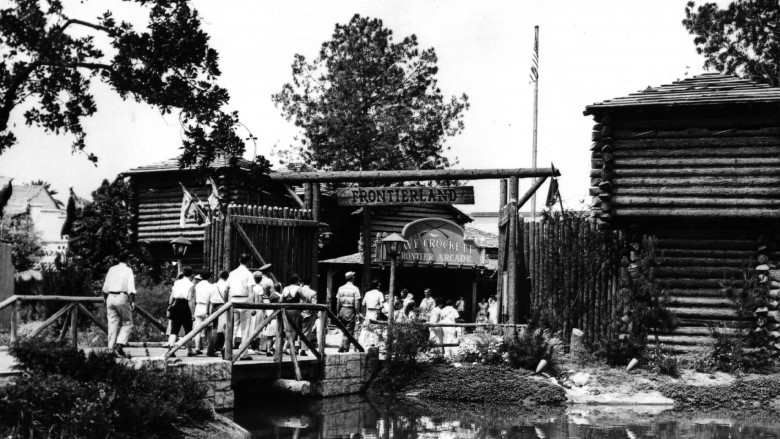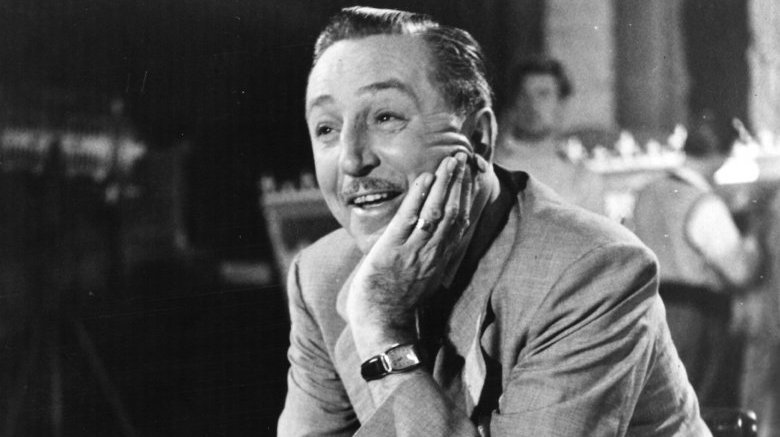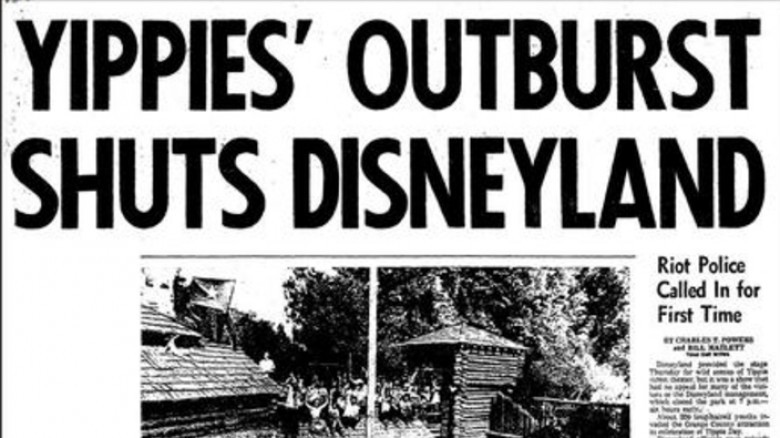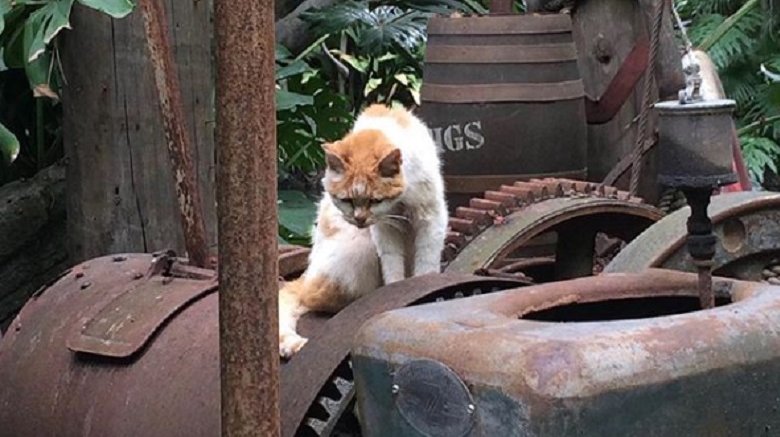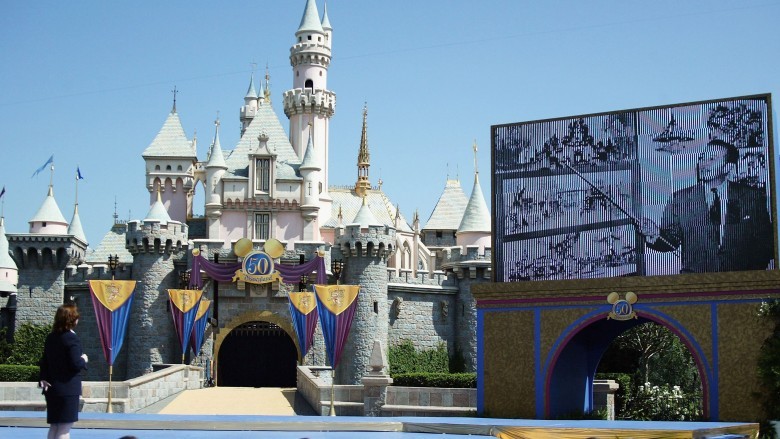The Untold Truth Of Disneyland
Disneyland, the legendary Anaheim, California, theme park, has been enormously popular since it opened in 1955. Even just saying "I'm going to Disneyland" became an advertising catchphrase. But as familiar as the "Happiest Place on Earth" may seem, there are still things you may not know the first Disney theme park that was one of Walt Disney's greatest achievements. And no, we're not talking about Walt's cryogenically frozen body—he's not frozen there, nor anywhere else.
Disneyland was not the first theme park
Amusement parks had been around in the United States since Coney Island's heyday, so Disneyland was obviously not the first. And theme parks (an amusement park based on one concept) started in the US a decade before Disneyland, with Santa Claus Land in Indiana being the originator of the concept in 1946.
Disneyland wasn't even the first theme park in southern California, as Knott's Berry Farm had led the way on that. Incidentally, Walter Knott of Knott's Berry Farm and Walt Disney had a cordial relationship. Knott was even invited to Disneyland's opening day.
What Disneyland offered, though, that differed from its predecessors was a theme park on a more massive scale, with the Disney characters people loved, from Mickey and Minnie Mouse to Dumbo to Peter Pan. Walt also had high-minded principles behind this undertaking, saying at the park opening that "the idea of Disneyland is a simple one. It will be a place for people to find happiness and knowledge," as well as "a place for parents and children to share pleasant times in one another's company."
Walt had a hard time getting funding for the park
Nowadays, Disneyland looks like a no-brainer. You'd think that using Disney characters and storylines would be an obvious idea when it came to a theme park, not to mention Walt's dream of having parents and children enjoying the park together.
Yet even his own company was not crazy about the idea of Disneyland. So Disney had to get creative on how to finance the park, Orange Coast Magazine reported. For starters, he borrowed on his life insurance policy. He then reportedly approached all three fledgling TV networks (television was in its infancy then) to see if they were interested in getting in on it, in exchange for a Disney show.
Only ABC, the lowest-rated network at the time, was interested enough in the park idea to hold a meeting with their top decision-maker and Disney. Walt's brother Roy met with CEO Leonard Goldenson in 1953 and did a presentation of what Walt had planned, The Washington Post reported that Goldenson asked how much he thought it would cost to build the park. Roy said $4–$5 million. The ABC exec thought it would be three times that amount, and in the end, it cost $17 million to finish Disneyland.
ABC agreed to give Disney $500,000 upfront, got approximately one-third ownership, and also guaranteed loans up to $4.5 million. In return, Walt Disney would make a show for them showing the progress in building Disneyland. The partnership was beneficial for both parties. His show Disneyland was the network's first tep 25 show (and first top 10 show). But Walt wanted his company to own the whole park outright, so in 1960, Disney had his company buy out ABC for $7.5 million. The Walt Disney Company would grow so big that it would buy ABC in 1995.
That wasn't the only way Disneyland got funding. We think of corporate sponsors as a modern innovation, but to help pay for the park, Disney also had companies like Frito-Lay, Eastman Kodak, Coca-Cola, and TWA sponsor rides and pavilions. Some of them owned Disneyland shares, but Walt bought them out as well.
Two men besides Walt had an awful lot to do with Disneyland
People think of Walt Disney as the man who came up with everything in Disneyland, but he had a lot of help. In 1953, Walt hired engineer Harrison "Buzz" Price, then of the Stanford Research Institute, to determine the best location for the park. Price asked Disney if he had any preference for where to locate the park, and Price said Walt told him, "Absolutely not," and directed him: "You tell me where the best location is."
The Los Angeles Times describes what happened next: "The engineer analyzed population trends, land prices, accessibility and climate—and zeroed in on a 160-acre orange grove in Anaheim." Price declared later: "We hit it right on the nose, dead center," and that the location "was the perfect place for it." In later years, Price stayed a trusted Disney adviser and would pick Orlando, Florida, for Disney's East Coast location, as well as run feasibility studies for theme parks like SeaWorld, Busch Gardens, and Six Flags.
Cornelius Vanderbilt Wood was also from Stanford Research Institute and became the very first Disneyland employee. He oversaw the park's construction, getting it completed in a year. Then Walt reportedly dumped him shortly thereafter. "There was room for only one showman," Price speculated in his 2004 book Walt's Revolution! By the Numbers. "Their clash of egos was oil and water and Walt was the boss." Some say Wood's contribution to Disneyland has been "written out" of the company's history.
When Disneyland relaxed hair rules for guests, the Yippies invaded
We think of the '50s as innocent times. But the amusement parks and carnivals in the US then (think freak shows and carnies) were pretty raunchy. And back then, people went to freak shows to see morbidly obese people in person. Today, they only have to go outside.
Anyhow, Walt wanted Disneyland to be a clean family park, and that started with a more wholesome look. So he had strict rules on men's haircuts and facial hair for cast members, as employees were known, even though Walt himself had a mustache. The bad guys in the Western skits at the park at the time also got to have facial hair, but they were bad guys, after all.
Even guests had to follow haircut rules up until the late '60s. In 1964, Jim McGuinn, the future leader of the Byrds, wasn't allowed in due to his Beatlesque haircut. But in 1970, Disneyland relaxed the hair rules for customers. And the left-wing youth activist group known as the Yippies, founded by Abbie Hoffman and Jerry Rubin, took advantage with an "International Yippie Pow-Wow" to be held on August 6, 1970. Disney expert Jim Hill wrote that the flyer for the day "was loaded with deliberately theatrical events, like a Black Panthers' hot breakfast at Aunt Jemima's Pancake House," as well as the "liberat[ion] of Minnie Mouse." The flyer also said the Yippies would roast Porky Pig. (Guess nobody told them that Porky was a Warner Brothers character.)
Disneyland was prepared for a horde of protesters that day. But only a few hundred Yippies showed up, leaders Hoffman and Rubin were no-shows, and most guests were reportedly more interested in going on the rides than paying attention to the Yippies. Disney security gently warned the Yippies to behave, or they'd be ejected. Most did, but some of them tried to climb up the rigging of the Chicken of the Sea Pirate Ship and Restaurant, Hill writes, and some others tried to take over the isolated Tom Sawyer Island.
Finally, Disney security had enough when some Yippies went to Main Street USA and did a certain chant beginning with an F (guests reportedly sang "God Bless America" in response), and one activist got in a fight with another guest when he tried to hang up the Yippie flag. Disneyland kicked out the Yippies, brought out 150 police in riot gear, and closed the park early.
The Disneyland of the 1950s is both the same (and different) from today
Original rides that still exist include the Mad Tea Party, King Arthur's Carrousel, Peter Pan's Flight, Mr. Toad's Wild Ride, the Jungle Cruise, Autopia, and Snow White's Scary Adventures. Most of the machinery has been updated. But rides like the Jungle Cruise are so dated with their technology and style that they have become comical, so the tour guides on the boats make jokes based on that.
Disneyland was growing right from the beginning, so many non-original rides, like Dumbo, the Matterhorn, the Monorail, the Enchanted Tiki Room, are still around today. These rides are over 50 years old, but they are not original rides.
While there are still those Disneyland rides of the '50s, some of the other attractions disappeared a long time ago. There was once a Main Street store to buy cigarettes and cigars. This tobacco shop lasted until 1991.
The bra store, charmingly titled "The Wizard of Bras," didn't last very long. Neither did the exhibit (by Monsanto, natch) about "the romance of chemistry." There were also mule rides and Conestoga rides.
About 200 cats live in Disneyland
Legend has it that cats have lived in Disneyland since almost the beginning, with a cat clan living in Sleeping Beauty's Castle that Walt found and wanted to keep alive. Initially, cats on the property were adopted out to cast members' families, according to the Disneyland Cats website. Now they get to stay.
Currently, there are reportedly about 200 cats in the park, all of whom are spayed and neutered. Disney employees feed the cats, and cat-friendly guests like to spot the fabulous felines strolling around the park. The cats help with rodent removal—ironic for an empire started by a mouse.
People have gotten injured and killed at the theme park
Disneyland is not always the Happiest Place on Earth, especially when it comes to people who try to get out of rides when they're still running. At least nine people have died in the park, mostly "the result of guests who apparently ignored safety instructions and/or defeated rides' safety mechanisms," according to Snopes.com.
There have also been multiple injuries. In 1998, the Occupational Health and Safety Administration cited Disneyland for violating 36 safety rules. And in 2013, Disneyland temporarily shut down The Matterhorn, Space Mountain, and Soarin' Over California after OSHA fined the company $234,000 for safety violations.
'It's a Small World' started as a lullabyesque ballad
"It's a Small World" is one of the most divisive things in Disneyland. It started at the New York World's Fair in 1964-65 before moving to Disneyland in 1966, and the audio-animatronic technology was seen as groundbreaking for its time. Since the theme of the fair was "peace through understanding," the song's message fit well.
The Sherman Brothers, who wrote the music for Mary Poppins and other classic movies, composed "It's a Small World." But the tune had a different tone at its inception. Richard Sherman wrote it as a "prayer for peace," and it was a slow-moving ballad. Walt asked it to be sped up, and it became one of the most beloved (and hated) songs in history, with the latter being the case for anybody who has had the misfortune of getting trapped in the ride when it broke down, or who were stuck in the long lines for the ride.
In 2009, a paraplegic man was stuck in the ride for 30 minutes and, unlike other guests, reportedly was not evacuated right away. He needed medical attention afterward. A court awarded him $8,000 in a lawsuit, with half going to "pain and suffering."
"It's a Small World" also might be the most played song of the 20th century, according to Time magazine, played over 50 million times. No wonder it's impossible to get it out of your head.
Walt had some regrets with Disneyland
Walt Disney was able to achieve his dreams for Disneyland and go way beyond that. But he did regret that he didn't buy enough land around the park to truly separate Disneyland from the rest of the world. Instead, all sorts of tacky motels and shops sprung up around the park. He would not make that mistake again when it came to Walt Disney World in Orlando.
RIchard Rodriguez described this on PBS on 2000: "Like other postwar urban planners, Walt Disney displayed both an innocence and an arrogance. To create the happiest place on earth, he needed to clear away all that's messy. Disneyland is scripted reality," he said. "To his disgust, neon and the honky-tonk of Anaheim intruded on the edges of his dream, so Disney planned a bigger park in Florida, where the messy world would be kept at bay."
Walt's personal touch is all over Disneyland
What differentiates Disneyland from Walt Disney World and the other Disney parks was that with his great attention to detail, Walt oversaw all of the attractions before his death in 1966. Disneyland is the only Disney park Walt ever was in. He also had a lot to do with rides that opened after his passing, like The Pirates of the Caribbean, which debuted three months after he died, and The Haunted Mansion, which opened in 1969.
Walt even had his own private apartment in Disneyland, above the firehouse, from which he could work and watch the crowds. Today, Disneyland leaves a light on in the apartment in his memory.
"Disneyland will never be completed," Walt once said. "It will continue to grow as long as there's imagination left in the world. It is something that will never be finished. Something that I can keep developing and adding to."
Over 50 years after Walt's death, the park is still growing, thanks to some creative planning, like using parking lots for increased building. There have been multiple expansions of Disneyland since 1955, including updated attractions, New Orleans Square, Mickey's Toontown, Downtown Disney, Disney California Adventure theme park, and Star Wars Land as a future "land."
